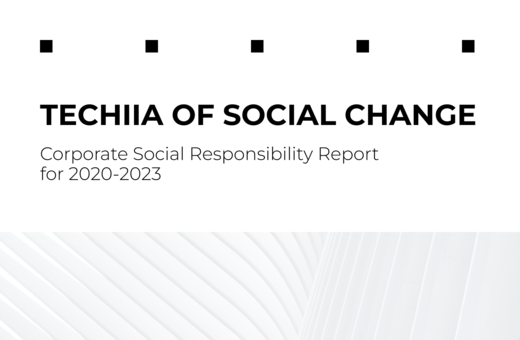
Elchin Aliyev, Chief Executive Officer of ENESTECH Software tells about why a cloud business needs pivot plans, and about possible mistakes when changing focus.

Elchin Aliyev, Chief Executive Officer of ENESTECH Software
“It is not the strongest of the species that survives, nor the most intelligent; it is the one most adaptable to change.” This is something Charles Darwin said almost 200 years ago. And just a couple of years ago COVID-19 showed that everything is just the same: whoever kept an emergency supply or quickly adapted to the new world stayed strong.
In this article, we'll talk about pivoting and mistakes that can undermine everything. I will draw on the experience of ENESTECH Software, part of the TECHIIA holding, and the lessons that our team has learned during the four years on the market. This information will come in handy for product managers, business development, and, of course, heads of software development teams.
From this article you will learn the following:
- what is a pivot, and when it is needed;
- what mistakes companies make when preparing for a pivot;
- how to explain to investors and CEOs that they need to allocate resources to prepare a pivot, especially if everything is going well.
Pivot and COVID-19
Pivot is a change in the company’s direction. The scale of the pivot varies: for example, Nokia, which we remember as a mobile phone manufacturer, was founded as a pulp mill. Throughout its history, Nokia has changed its business vector several times: it was engaged in energy, car tires, telephone and telegraph cables, and finally - in electronics.
2020 has pushed many companies towards a U-turn. Airbnb has launched a video tutorials line under the 'Experience' category. Spotify has added podcasts to streaming music. BMW started actively sponsoring online esports events as all traditional sporting events were canceled and the brand needed new advertising channels.
In fact, a pivot can be a change in a market, a niche, a new product launch, or a reassessment of the target audience. Sooner or later, any company is faced with it. Here are the errors the company might face in this process.
Mistake 1. Too late to pivot
A pivot plan, preferably a detailed one, should be in stock with any technology company. Many ignore its importance until a crisis strikes until the business begins to lose momentum or earnings.
Our company is developing , a SaaS product for LAN gaming centers and esports arenas. Long before the 2020 quarantine measures, we were looking for alternative income sources. But it was the lockdown that pushed us to make it faster: in case LAN centers are closed, they don't need automation platforms.
Our reserve funds helped us big time back then. We have strengthened the development, added new ways of monetization to cover related niches. In 2021, our users gradually returned to work, our traditional income sources have recovered - but now we have new ones as well. We are now customizing SENET for the education sector so that we have another alternate airfield if the LAN-centre business suddenly goes down again.
But the crisis is not the only reason to think about new growth prospects. Here are just a few of the warning signs that a pivot is needed:
- the product does not completely fit the market: the hypothesis was not confirmed, the needs of the target audience changed, they studied little or did not understand the market, competitors;
- a new competitor has appeared;
- product costs do not pay off;
- things are going well so the product is not growing.
The last point is the trap. When a product sells well, the company runs the risk of getting bogged down in perfectionism. Instead of coming up with B/C/D plans, the team spends time improving operations and business processes, but not looking for any new opportunities for the product.
In this case, it is useful to ask yourself the "What if?" question. What if the segment we work in collapses tomorrow? What if a powerful competitor appears? What if technology is no longer innovative?
From the moment the product is launched, I recommend that product managers and business development allocate small resources in advance to research possible pivoting. You can start with the basics, namely:
- study competitors, their target audience, monetization models;
- identify pros and cons of competing products;
- identify a list of new potential countries and markets: what part of the audience can you take and in which particular country?
- make a plan for the development of additional functionality and possible problems that you can solve for your audience in the future.
Your research should be well-reasoned and supported by facts so that the team, investors, and partners are ready at any time to support that change of direction.
Mistake 2. Overpricing or underpricing
After a pivot, your product can be the best in the world and very useful, but what's the point if the market can't handle your price? If the price is too high, you can prove for a long time that there is nothing better and close 1-2 deals. And if you underestimate it, you simply will not pay off.
If you want massive sales, you need to research the market and check if the value of your product matches the needs of your target audience.
When we bring SENET to a new market, we conduct hundreds of product interviews. We invite people from esports, local business, education and tell about the product. They, in turn, tell us about their business, costs and earnings, staff, and plans for the future. It happens that people themselves say what they lack and how they see the product to solve their problems.
To form an adequate price, we directly ask about the financial performance of the interlocutor and how much he/she is willing to pay for the product. In parallel, we look at the competitors’ prices, we calculate the number of gamers per day, the duration of the session, we estimate the rent cost, the approximate salaries, and computer update costs. As a result, we get the average value of the net profit of our potential client.
Our task is to show that the software:
- will not cost more than 3-5% of net earnings;
- will solve the pain;
- will pay off several times in a month.
When we decide on the price, we need to clarify the sales mechanism for ourselves. For example, in existing markets, 2 sales managers and 2 business development managers bring 50 sales per month. Will you be able to sell the same amount in a new region if you hire two people there? To do this, do not forget to study the volume of the market at the stage of product interviews.
Mistake 3. Choosing the wrong niche
It happens that a small company pivots into a niche where there are already world-class competitors. It is useless to go where Oracle controls the market, don’t you agree? You may have an ambitious idea to make something better than Oracle, but while you’d be spending a lot of money and time on development, the giant will go far ahead.
Instead of chasing the clouds, it is better to concentrate on specific functionality to hit a competitor's blind spot. To do this, you need to perform three steps:
- Speak with clients, current and potential. Tell them about the product, even if it is not out yet, ask about possible problems with its use and methods of solving them.
- Monitor targeted queries on the Internet. We are all looking for a solution in the Google search bar for the most part. If your target audience needs help, you will learn about it from social networks, forums, and articles.
- Strengthen the competitors' activity tracking. They may have done the first 2 points and are now testing a new hypothesis.
When spying on competitors, it is important to watch how they interact with the customer, what value they are selling. You can often see features that your product lacks. They are also important. But they can also lead to the next mistake.
Mistake 4. Over-focusing on features
The Ferrari car has 4 wheels and a steering wheel - these are its features. The Volkswagen Beetle also has 4 wheels and a steering wheel. But their value is different. The Italian manufacturer sells premium quality, comfort, and design. Beetle sells the ability to go from point A to point B at an affordable price.
As a search for new ways to monetize, we are currently developing a built-in tournament module for SENET. It is a comprehensive product that will make it easier for LAN gaming centers to host local tournaments for amateur players. The platform is being created together with WePlay Esports the international esports media holding and makes it possible to integrate a local tournament into the global esports competitions ecosystem.
At the same time, there is already a Challonge on the market - a platform that is used by amateur players to quickly showcase the standings among their friends. Both products will be referred to as “tournament platforms”. But it must be remembered that the scale of application and the additional value they have is completely different.
Of course, in the competitive struggle, the functional advantages of the software are important. But the needs of the target audience should be prioritized, as users may need a better service, more comprehensive support, ease of installation and use.
To understand what value competitors are selling, my team and I go through the standard consumer journey. Even several. We see how they react to a phone call, to an application through a blog or direct. Whether the demo is prompt enough. How they act if we do not reply to messages, whether they send a follow-up after a while or completely forget. What exactly do they tell about the product and how delicately they lead us to close a deal.
After field research, I conclude whether, as a consumer, want to make a deal with that company and for how long, whether there is anything relevant for our company, and what mistakes we should avoid.
Mistake 5. To ignore the specifics of your local target audience and the region in general
This is a classic sales mistake that many people forget about. You need to be clear about who makes the decision to buy your product and who influences it.
Our main target audience is the owners of LAN gaming centers and esports arenas. To develop the main functionality, we focus on their main pains: managing financial flows and providing quality service. But when we implemented ad integrations in the product, we realized that we were aiming at a completely different audience - gamers. To do this, we had to dive deeply into the user experience of the visitors.
Now, while working on a pivot for the education niche, we are negotiating with deans and teachers of esports specialties. We talk about SENET as it is, to find out whether it fits for integration into the ecosystem of educational institutions. If so, then the institution manages to allocate a budget for product testing without major changes in the product. We had such a case in the United States. At the same time, we are introducing customization of SENET exclusively for colleges and universities to fully cover the needs of the niche in other countries in the future.
Ignorance of socio-cultural specifics in local markets can also undermine the success of pivoting. For example, getting ready to enter the Vietnamese market, we learned that most of the population uses their social network Zalo with an integrated messenger. That is, it makes no sense to write in WhatsApp, which is an ordinary messenger for us. Even if a person has installed it, likely, he/she will not answer there. In Thailand, Line is used more for quick messages.
The most memorable experience came from Turkey. The name of the product, "senet", elicited smiles and bewildered looks at the first negotiations. Then they explained to us that in Turkish this word means “debt obligation”. Not the best label for a new product, right?
At first, we thought people would get used to it, but soon we renamed SENET to ENES-T for the local market. There were no problems with the updated name, especially since Enes is a common name in Turkey and Arab countries.
These cultural clashes affect the business performance of a product as much as bugs and design. That is why we form a multinational team: only a native speaker of the language and culture can truly understand the pains of a particular region and the specifics of business behavior. At a minimum, I recommend using the services of local consultants, the more the better.
The conclusion from the above will be short. The more thoroughly and more you research the market, the more you understand the pain of potential customers. The smaller holes you see in your competitors' performance, the better chance of success your product has. Changing a line from the world’s bestseller, In the beginning, was the Research, and the Research was God.
Original article on


